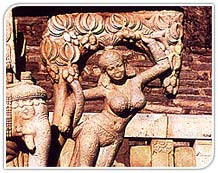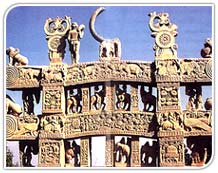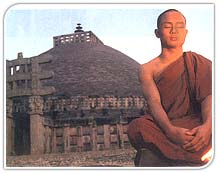 Sanchi
is known for stupas, monasteries, temples and pillars dating from the 3 rd
century BC to the 12th century AD. The most famous of these monuments, the
Sanchi Stupa 1, was originally built by the Mauryan Emperor Ashoka, the
then governor of Ujjayini, whose wife Devi was the daughter of a merchant
from adjacent Vidisha. Their son Mahindra and daughter Sanghamitra were
born in Ujjayini and sent to sri Lanka, where they converted the king, the
queen and their people to Buddhism.
Sanchi
is known for stupas, monasteries, temples and pillars dating from the 3 rd
century BC to the 12th century AD. The most famous of these monuments, the
Sanchi Stupa 1, was originally built by the Mauryan Emperor Ashoka, the
then governor of Ujjayini, whose wife Devi was the daughter of a merchant
from adjacent Vidisha. Their son Mahindra and daughter Sanghamitra were
born in Ujjayini and sent to sri Lanka, where they converted the king, the
queen and their people to Buddhism.
The world-renowned stupas of
stupa of Sanchi in Madhya Pradesh are being designated by UNESCO as the
world heritage site for its archaeological andhistorical importance.
A
Chunar sandstone pillar fragment, shining with the proverbial Mauryan
polish, lies near Stupa 1 and carries the famous edict of Ashoka warning
against schism in the Buddhist community. Stupa 1 was found empty , while
relics of the two disciples of Buddha enshrined in the adjacent Stupa 3
were carried away to England. The nearby moern temple has a reliquary
containing the remains of a Buddhist teacher from another stupa outside
Sanchi.
 The
Sanchi hill goes up in shelves with Stuupa 2 situated on a lower shelf,
while Stupa 1, Stupa3, the 5th century Gupta temple No. 17 and the 7th
century temple No. 18 are on the intermediate shelf while a later
monastery is on the crowning shelf. The balustrade surrounding Stupa 2,
carved with aniconic representations of the Buddha, was added in the late
2nd century BC under the Shungas, while the four gateways of Stupa 1 were
built in the 1st century BC under the Satavahanas.
The
Sanchi hill goes up in shelves with Stuupa 2 situated on a lower shelf,
while Stupa 1, Stupa3, the 5th century Gupta temple No. 17 and the 7th
century temple No. 18 are on the intermediate shelf while a later
monastery is on the crowning shelf. The balustrade surrounding Stupa 2,
carved with aniconic representations of the Buddha, was added in the late
2nd century BC under the Shungas, while the four gateways of Stupa 1 were
built in the 1st century BC under the Satavahanas.
Carved with
stories of the Buddha's past and present lives and with incidents from the
subsequent history of Buddhism, the gateways are the finest spenciments of
early classical art, which formed the seedbed for the entire vocabulary of
later Indian art.
Two fo the moving stories told on these portals
are those of Prince Vessantara, who gave away his wealth, his wife and
children out of charity and compassioin, and of Buddha who, as the monkey
king, sacrificed his life to wave his companions.
The
inscriptions on the gateway mention donors from all over northern India
and special mention is made of the ivory workers of Vidisha who sculpted
the stone with the precision of jewelers.
 The
adjacent Gupta temple No. 17 was hailed by Sir John Marshall as one of the
most rationally organized structures in Indian architecture. Though small,
it was a herald of all the principles which went into the engineering of
an Indian temple in the early medieval period. The Buddhas in the
perambulatory surrounding Stupa 1 are not contemporary with the Stupa but
belong to the Gupta period in the mid-5th century A.D The monastery and
the temple with the tall pillars adjacent to Stupa 1 and the temple near
the monastery on the crowning shelf illustrate the evolution of the
architectural form after the 5th century Gupta temple.
The
adjacent Gupta temple No. 17 was hailed by Sir John Marshall as one of the
most rationally organized structures in Indian architecture. Though small,
it was a herald of all the principles which went into the engineering of
an Indian temple in the early medieval period. The Buddhas in the
perambulatory surrounding Stupa 1 are not contemporary with the Stupa but
belong to the Gupta period in the mid-5th century A.D The monastery and
the temple with the tall pillars adjacent to Stupa 1 and the temple near
the monastery on the crowning shelf illustrate the evolution of the
architectural form after the 5th century Gupta temple.
Below the
hill, the Archaeological Survey of India Museum houses, some of the
earliest known stone sculptures in Indian art from the 3rd to the 1st
century BC while the adjacent town of Vidisha has a state museum with
medieval sculptures. The nearby monuments, like the 2nd century B. C.
Heliodoros Pillar, the 5th century a.D. Udayagiri Caves and the Lohangi
Hill monuments in vidisha are situated within as radius of 10 km from
sanchi, and are well worth a visit.
How to Reach :
By
Air : Nearest airport is at Bhopal (46 km via Diwanganj and 78 km via
Raisen) which is connected with Delhi, Mumbai, Gwalior and Indore.
By
Rail : Sanchi lies on the Jhansi-Itarsi section of the Central
Railways> However, the most convenient railhead is Vidisha (10 km).
By Roads: Good, motorable roads connect Sanchi with Bhopal,
Indore, Sagar, Gwalior, Vidisha and raisen, besides other places. Special
Offers on Hotels & Resort Booking in Madhya PradeshTravel
Agents & Tour Operators offering Travel Packages to Madhya PradeshSanchi is known for stupas, monasteries, temples and pillars dating from the 3 rd century BC to the 12th century AD. The most famous of these monuments, the Sanchi Stupa 1, was originally built by the Mauryan Emperor Ashoka, the then governor of Ujjayini, whose wife Devi was the daughter of a merchant from adjacent Vidisha. Their son Mahindra and daughter Sanghamitra were born in Ujjayini and sent to sri Lanka, where they converted the king, the queen and their people to Buddhism.
The Sanchi hill goes up in shelves with Stuupa 2 situated on a lower shelf, while Stupa 1, Stupa3, the 5th century Gupta temple No. 17 and the 7th century temple No. 18 are on the intermediate shelf while a later monastery is on the crowning shelf. The balustrade surrounding Stupa 2, carved with aniconic representations of the Buddha, was added in the late 2nd century BC under the Shungas, while the four gateways of Stupa 1 were built in the 1st century BC under the Satavahanas.
The adjacent Gupta temple No. 17 was hailed by Sir John Marshall as one of the most rationally organized structures in Indian architecture. Though small, it was a herald of all the principles which went into the engineering of an Indian temple in the early medieval period. The Buddhas in the perambulatory surrounding Stupa 1 are not contemporary with the Stupa but belong to the Gupta period in the mid-5th century A.D The monastery and the temple with the tall pillars adjacent to Stupa 1 and the temple near the monastery on the crowning shelf illustrate the evolution of the architectural form after the 5th century Gupta temple.